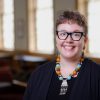This article is more than 5 years old.
Earlier this semester, I completed my first MOOC, An Introduction to the U.S. Food System, offered through Coursera by the Johns Hopkins Bloomberg School of Public Health. While I didn’t learn as much new information as I assume others did (not a criticism of the course, more that I’ve been learning about food issues for a number of years now), learning about our food system was only a partial goal in signing up. Given all the hoopla around MOOCs, I wanted to personally experience what some seem to see as the shiny new future of higher ed.
MOOCs are Massive Open Online Courses, and they have captured the fancy of many in higher ed, and beyond. MOOCs offer students the opportunity to learn from noted scholars, without incurring tuition costs, from the comfort of wherever they happen to be. While MOOCs may not be the future of higher ed reform – and there’s been some recent criticism – they can’t be overlooked entirely.
I embarked on my MOOC hoping to be wowed into tempering my cynicism that they are the saving grace of higher ed’s current problems. That didn’t happen (criticisms below), but there was one surprising insight that only occurred once I became a student myself: if MOOCs are going to stick around in some variation, it is imperative that researchers make sure their articles and books can be used for course content; aka, scholarship must be openly accessible. I came to this realization myself while working through my MOOC assignments, but was reassured to learn that Kevin Smith at Duke University also sees the need for a MOOC-Open Access correlation.
My MOOC involved weekly video lectures, required and optional readings, discussion forums, and quizzes. The readings are where I felt the closest affinity to a traditional course, as both my MOOC and a Geography course on food systems I took as an undergraduate relied on articles in lieu of a textbook. However, the nature of those readings were quite different. In my MOOC, of 55 readings (the vast majority optional), only 8 were scholarly articles, 7 OA. One optional reading was an article that explicitly required institutional access (alas, WFU didn’t subscribe), and two were non-research articles from scholarly journals. The rest were newspaper articles, reports, websites, and other pertinent but not scholarly readings.
What strikes me about the non-scholarly nature of the majority of the readings is that: a) this is a topic that can be covered by non-scholarly articles and reports, but that b) only ONE of the required readings was an OA scholarly article. I cannot speak to whether or not the reliance on non-scholarly readings would be similarly reflected on the syllabus of a correlated course taught at JHU, but my guess is that if this had been a traditional course, more than one of my assigned readings would have been from a scholarly source.
Setting aside my additional criticisms (simplistic assignments, no real feedback opportunities, unwieldy forums) that cast MOOCs* in a poorer light than traditional courses, college classes incorporate scholarship through assigned and supplemental course readings and student research. But when the availability of scholarly readings are limited, as they are in MOOCs, I fail to see how it can be argued that they are an acceptable substitute for credit-based classes.
Does this make my MOOC inherently bad? Of course not! I quite enjoyed my learning experience, despite a strong base of knowledge coming in. But having experienced both a MOOC and a traditional course on essentially the same topic, I cannot buy into the claim that MOOCs are the future of higher ed, without substantial shifts to open scholarly publishing and distribution systems.
___
* Admittedly, I’m making a broad generalization here, as I’ve only taken one MOOC, so my experience is quite limited. I’ve heard that other have more rigorous assignment. My second MOOC starts today – perhaps I’ll have more “homework” to do this time around!

5 Comments on ‘My MOOC Experience’
This is great, Molly. So glad you took the plunge. My most positive MOOC experiences came in courses where I had no desire for college credit, but just wanted exposure to the content. For that it worked great. The OA content question will come into play not only with MOOCs but other kinds of collaborative online learning that WFU and others are now entertaining. So much fun to figure out!
Thanks for sharing!
Excellent point, Molly. I see the two efforts (MOOCs and OA) as being in close philosophical alignment. If OA is aimed at increasing access to the world’s knowledge, then MOOCs, really, are just free guided tours through small sections of the world’s knowledge. Right now, unfortunately, the knowledge most MOOCers have access to forces MOOCs to only stop off at the Wall Drugs of the knowledge world, when OA would allow us to show them the Louvre. Does that horrible analogy make any sense?
Kyle, I really like your characterization of MOOCs as guided tours through subsets of knowledge! And your analogy definitely makes sense.
Interesting news from Coursera this morning about a collaboration with academic publishers to make e-textbooks available to MOOC students for the duration of their courses: http://online.wsj.com/article/PR-CO-20130508-910631.html.